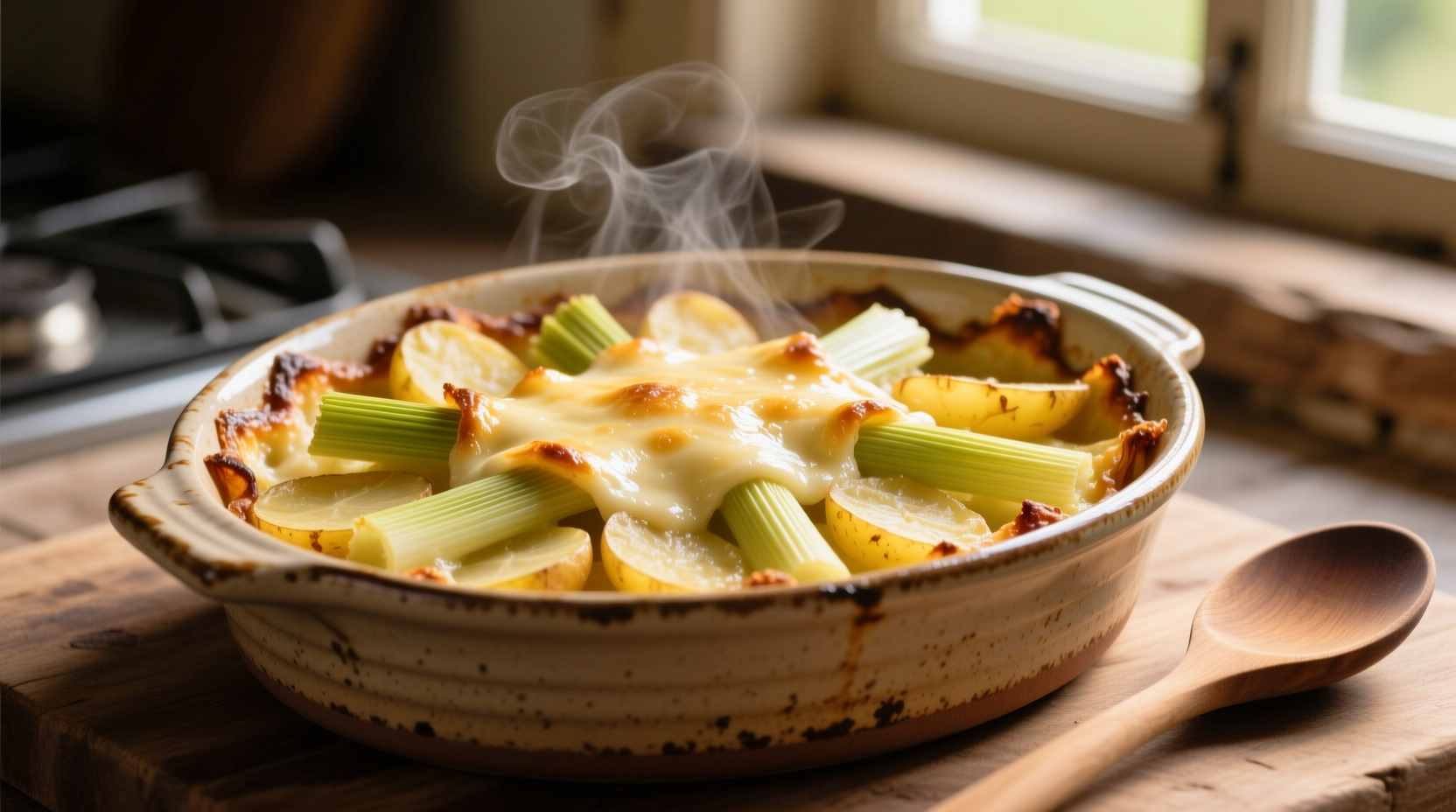Leek and potato gratin isn't just another side dish—it's a culinary masterpiece that transforms humble ingredients into something extraordinary. When executed properly, this French classic delivers velvety layers of tender potatoes, sweet caramelized leeks, and a perfectly bronzed crust that crackles with each serving. The magic happens through precise layering, temperature control, and understanding how these simple components interact during baking.
The Science Behind Perfect Gratin Texture
Understanding the chemistry of your ingredients separates good gratin from exceptional gratin. Potatoes contain two starch types: amylose (which gels when heated) and amylopectin (providing structure). When sliced uniformly at 1/8-inch thickness, these starches release gradually, creating that signature creamy-yet-defined layering. Leeks, with their natural sugars, undergo Maillard reactions at 300°F (149°C), developing complex flavors without burning when properly layered beneath the potato top layer.
| Ingredient | Optimal Ratio | Texture Contribution | Flavor Development |
|---|---|---|---|
| Potatoes (Yukon Gold) | 2:1 by volume | Starchy foundation | Earthy sweetness |
| Leeks (white/light green) | 1:1 by volume | Delicate layers | Caramelized notes |
| Heavy cream | 1 cup per 2 lbs produce | Binding agent | Rich mouthfeel |
| Gruyère cheese | ½ cup grated | Crisp topping | Nutty complexity |
Step-by-Step Preparation Guide
Follow this chef-tested method for flawless results:
Ingredient Preparation
Clean leeks thoroughly by slicing lengthwise and soaking in cold water to remove hidden grit. Use only the white and light green portions, discarding dark green sections. Slice potatoes using a mandoline set to 1/8-inch thickness—this precise measurement ensures even cooking without disintegration. According to the USDA Food Data Central, Yukon Gold potatoes contain 15% less water than Russets, making them ideal for gratin's creamy texture.
Layering Technique
Begin with a thin leek layer to create a flavor foundation. Alternate potato and leek layers while slightly overlapping each slice like shingles. Season each layer with fleur de sel and freshly cracked white pepper—avoid black pepper which can turn bitter during baking. The critical ratio: 3 potato layers per leek layer maintains structural integrity while allowing flavors to meld.

Baking Process
Pour warm cream (never cold) over the layered ingredients, ensuring complete saturation. Bake covered at 325°F (163°C) for 45 minutes, then uncover and increase to 375°F (190°C) for final browning. This two-stage method prevents premature surface drying while allowing starches to fully gelatinize. The gratin is done when a knife inserts with slight resistance—this indicates properly set layers that will hold their structure when served.
Historical Evolution of Gratin Techniques
Gratin preparation has evolved significantly since its 17th century origins:
- 1651: François Pierre La Varenne's Le Cuisinier François first documented "gratiner" as browning with hot iron
- 1800s: Introduction of cheese toppings in Alpine regions for added richness
- 1920s: Julia Child's mentor, Louis Diat, standardized cream-to-produce ratios
- Modern: Precision temperature control replacing traditional wood-fired ovens
Common Problems and Professional Solutions
Even experienced cooks encounter these issues:
Soggy Bottom Layers
Cause: Excess moisture from improperly drained ingredients. Solution: Salt potato slices and let rest 15 minutes before layering to draw out water. The FDA Food Code recommends this moisture reduction technique for optimal food safety and texture.
Uneven Browning
Cause: Inconsistent oven temperature. Solution: Rotate dish 180 degrees halfway through uncovered baking. Professional kitchens use convection settings at 25% power for even heat distribution.
Curded Sauce
Cause: Cream boiled too vigorously. Solution: Maintain baking temperature below cream's scald point (180°F/82°C). Adding 1 teaspoon cornstarch per cup of cream stabilizes the emulsion without altering flavor.
Contextual Application Guide
Understanding when and how to serve leek and potato gratin maximizes its impact:
- Best occasions: Holiday meals, dinner parties, spring-summer menus (lighter than traditional potato gratin)
- Avoid serving with: Heavy cream-based sauces (creates texture competition)
- Ideal pairings: Roasted chicken, seared scallops, or as part of a vegetarian main with green salad
- Make-ahead tip: Assemble 24 hours ahead; bake 15 minutes longer if starting from cold
Professional Variations Worth Trying
Elevate your basic gratin with these chef-approved adaptations:
- Herb-infused cream: Steep thyme and bay leaf in cream for 30 minutes before use
- Truffle enhancement: Add ¼ teaspoon truffle oil to cream mixture (not during baking)
- Dairy-free version: Substitute cashew cream with 2% agar-agar for binding
- Regional twist: Add 2 tablespoons Pernod during layering for Provençal flair
Serving and Storage Guidelines
Let gratin rest 10-15 minutes after baking—this crucial step allows starches to fully set. Serve in warm dishes to maintain temperature. For leftovers, store in airtight container for up to 3 days. Reheat at 300°F (149°C) with splash of cream to restore moisture. Freezing is not recommended as potato cells rupture, causing texture degradation.
Frequently Asked Questions
Here are answers to the most common questions about perfecting leek and potato gratin:











 浙公网安备
33010002000092号
浙公网安备
33010002000092号 浙B2-20120091-4
浙B2-20120091-4